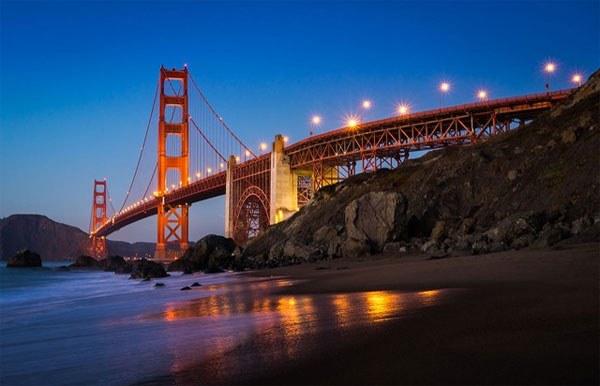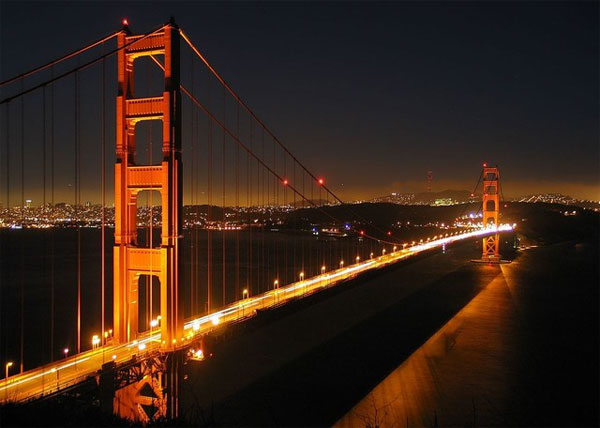January 5: The Golden Gate Bridge is built across San Francisco Bay
When completed in 1937, The Golden Gate Bridge is the longest suspension bridge in the world and has become an international symbol of San Francisco, California.
The Golden Gate Bridge (Golden Gate) is a suspension bridge connecting the Golden Gate, the gateway of San Francisco Bay and the Pacific Ocean. When completed in 1937, The Golden Gate Bridge is the longest suspension bridge in the world and has become an international symbol of San Francisco, California, USA. Since its completion, there have been eight other bridges spanning the Golden Gate Bridge.
Although the idea of a bridge spanning the Golden Gate has existed before, it was not until 1916 that the idea came up in a San Francisco newsletter. According to the City Association of Engineers estimates, the construction of a bridge costs $ 100 million, a figure that is too large for that period.

Joseph Strauss, an engineer, said he could build such a bridge at a much lower cost. In his first drawings, Strauss designed a big jack on both sides of the strait, these two ends connected by a hanging in the center where according to Strauss this segment could be built with 17 million USD.
Construction began on January 5, 1933, with a total cost of more than US $ 35 million. Strauss is the head of the project, overseeing daily construction and participating in groundbreaking.

Many engineers and experts have contributed from the technique to the art of adhering to the bridge which is both majestic and grandiose and colorful in the daylight to splendor under the night light.
The center bridge is the longest bridge in the suspension bridges until 1964, when the Verrazano-Narrows bridge was erected between New York's Staten Island and Brooklyn districts. The towers of the Golden Gate Bridge are also the tallest suspension bridge towers in the world at that time.

The weight of the circulation section is transferred to two cables through the two main towers and fixed to the concrete at the ends. Each cable is made of 27,572 metal fibers. The total length of the strands constituting two main cables is 129,000km; This total length is 5.79 times the diameter of the Earth.
Due to the suspension bridge with a length of up to 2,737m, with a central bridge with a length of 1,280m, Golden Gate Bridge is greatly affected by weather conditions, especially wind storms. Since its completion, the Golden Gate Bridge has been closed three times due to weather conditions: on December 1, 1951 due to strong winds of up to 111km / hour; on December 23, 1982, due to strong winds of 113km / hour; and on December 3, 1983 with winds of 121km / hour.

Modern insights into the impact of earthquakes on buildings have made people interested in strengthening seismic resistance for the Golden Gate Bridge. Because this bridge is located near the San Andreas fault, a fault is likely to cause major earthquakes. When thinking of the possibility of being able to withstand the earthquakes predicted, the completed bridge could be destroyed in structure (such as collapse) by the destruction of the bearing on the 98 m high arch on the Fort. Point. A $ 392 million program was conducted to upgrade the bearing capacity of the structure with the smallest damage.
- The longest plan to rebuild cable-stayed bridges in the world after 80 years
- Mobile divider moving system on Golden Gate Bridge
- 5 artificial landscapes visible from the universe
- The bridges have impressive architecture
- Detect the missing ship at the Golden Gate Bridge
- Video: Admire San Francisco via impressive Time-Lapse video
- Impressive moment with nature's
- This is what you see from the top of the highest places in the world
- The beam of Cau Vang image of Da Nang is mesmerizing for tourists
- Impressive bridges in the world
- 'Round eyes' with 'cross-bridge' in Japan
- Steam Cleaning - technology used to clean Ngo Mon Gate of Hue Citadel
 Norway built the world's tallest wooden tower
Norway built the world's tallest wooden tower Kremlin
Kremlin Ashurbanipal: The oldest royal library in the world
Ashurbanipal: The oldest royal library in the world Decoding the thousand-year construction of Qin Shihuang shocked the world
Decoding the thousand-year construction of Qin Shihuang shocked the world